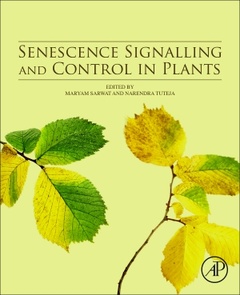Senescence Signalling and Control in Plants
Coordonnateurs : Sarwat Maryam, Tuteja Narendra

Senescence Signalling and Control in Plants discusses the studies showing the importance of hormone action on developmental senescence. It shows the involvement of various signaling components (such as EIN2, LOX2) and transcription factors (such as oresara1 or ORE1) in controlling hormonal activity during senescence. Further, the involvement of various micro RNAs (miR164, miR319) in regulating leaf senescence are discussed. Through this book, the authors throw light on all the reverse and forward genetic approaches to reveal the role of various other phytohormones regulating plant senescence and the molecular mechanisms involved.
Chapters on relevant topics are contributed by experts working in the area, making this a comprehensive treatise designed to provide an in-depth analysis on the subject matter.
1. The Physiology and Molecular Biology of Stress Induced Senescence 2. Abiotic Stress and Plant Senescence 3. Plant leaf senescence: Integrating multiple environmental and internal cues 4. Signal Transduction in Leaf Senescence: An Overview 5. Regulation of Leaf Senescence by Macromolecular Degradation and Hormones 6. The Role of Growth Regulators in Senescence 7. Jasmonic acid (JA) Mediated Signaling in Leaf Senescence 8. Polyamine as Signaling Molecules and Leaf Senescence 9. Oxidative Stress and Leaf Senescence: Important Insights 10. Proteolytic Processing During Leaf Senescence 11. Role of Histones During Leaf Senescence 12. Receptor-like kinases control of the development, stress response and senescence in plants 13. Flower senescence: present status and future aspects 14. Nutrient Remobilization During Senescence 15. Autophagy and Senescence 16. Plant Senescence and Organ Abscission 17. Autophagy and Senescence 18. Plant Senescence and Agriculture
Academia (Students, Faculty) in Plant Sciences, particularly Plant Biochemistry and Plant Molecular Biology, as well as those in Agriculture and Environmental Sciences
An elected fellow of numerous national and international academies, Dr. Narendra Tuteja is currently Professor and head at Amity Institute of Microbial Technology, NOIDA, India, and visiting Scientist at International Centre for Genetic Engineering & Biotechnology (ICGEB), New Delhi, India. He has made significant contributions to crop improvement under adverse conditions, reporting the first helicase from plant and human cells and demonstrating new roles of Ku autoantigen, nucleolin and eIF4A as DNA helicases. Furthermore, he discovered novel functions of helicases, G-proteins, CBL-CIPK and LecRLK in plant stress tolerance, and PLC and MAP-kinase
- Throws light on the involvement of hormones (other than the well- known hormones cytokine and ethylene) in plant senescence
- Shows the underlying mechanisms on the hormonal actions during senescence
- Exhibits the involvement of microRNAs during this important plant developmental process
Date de parution : 12-2018
Ouvrage de 322 p.
19x23.3 cm
Thèmes de Senescence Signalling and Control in Plants :
Mots-clés :
<; P>; factors Ethylene; Cytokine; signalling; ageing; micro RNA; transcription<; /P>



